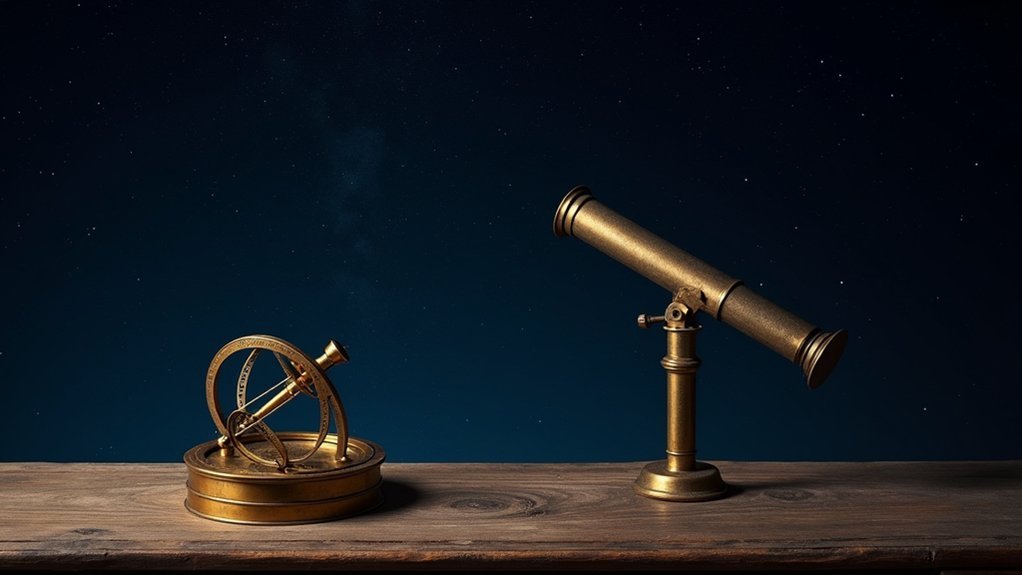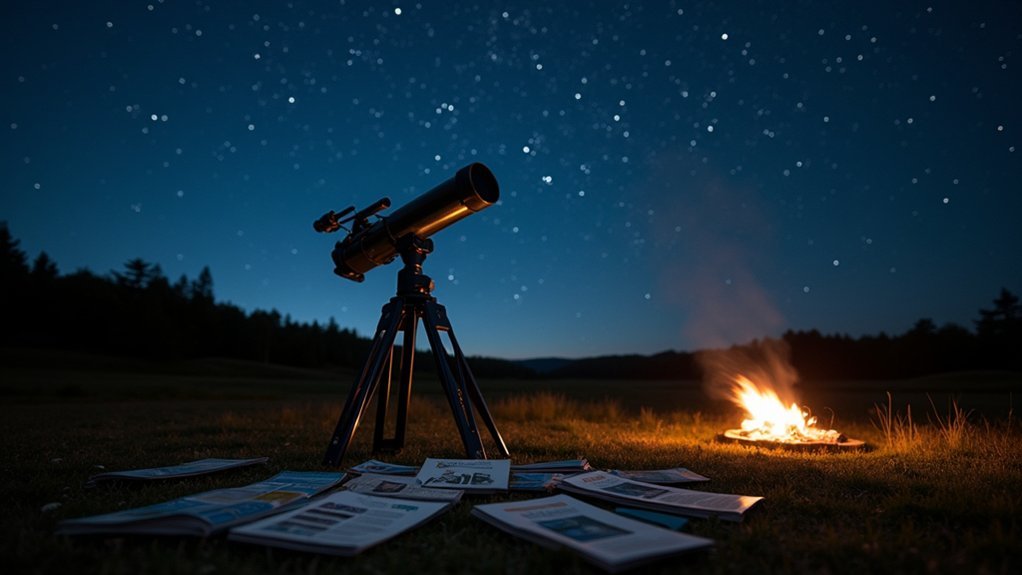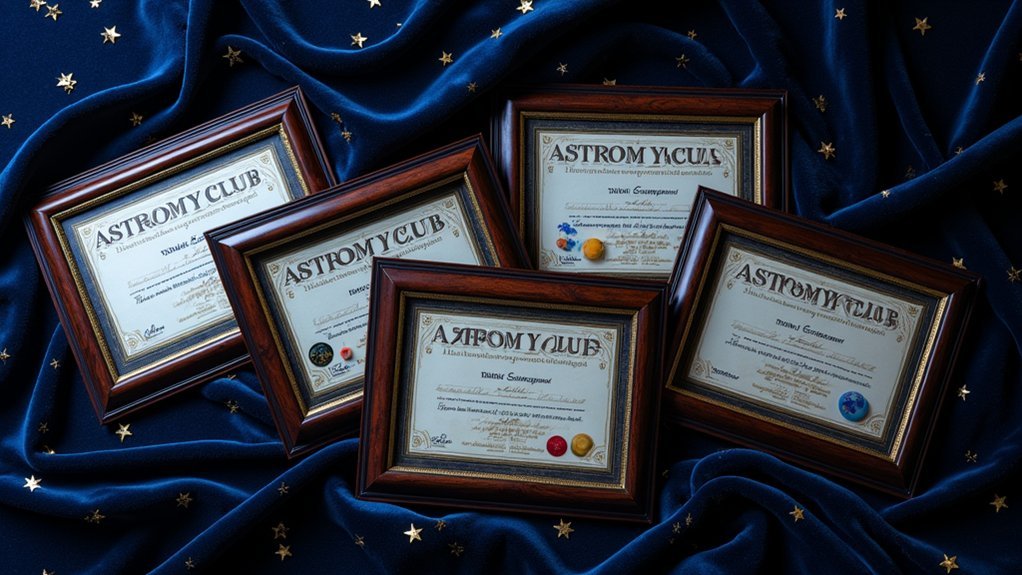Measure the stars with simple tools like your hands (fist spans 10°, pinky covers 1°), binoculars (7-10x power), or smartphone apps like Stellarium. Create a DIY sextant to determine latitude using the North Star, or try star hopping from familiar constellations using common objects as sighting tubes. Digital planispheres help identify celestial objects by their coordinates. These ancient and modern techniques reveal the universe’s secrets without expensive equipment.
Beginner’s Guide: Simple Tools To Measure The Stars

Five simple tools can transform your stargazing from casual observation to actual measurement. Binoculars are perfect for beginners, offering a wider field of view that makes locating stars and constellations easier than with telescopes. Choose 7-10 power models to enhance what you can see with the naked eye.
Take your stargazing to the next level with simple tools that transform night sky watching into meaningful astronomical measurement.
The ancient astrolabe remains relevant today, with its rete, mater, and rule allowing you to measure star altitudes and predict positions. A sextant helps determine your latitude by measuring the North Star’s height above the horizon.
Understanding measurement units like light-years (5.88 trillion miles) and parsecs (3.26 light-years) gives context to cosmic distances.
The parallax method demonstrates how astronomers calculate distances to nearby stars using Earth’s orbital movement.
Understanding Angular Measurement in the Night Sky
The night sky becomes measurable once you grasp angular measurement—how astronomers quantify celestial positions and distances.
When you look up, you’re fundamentally viewing a vast dome where objects are positioned at various angular separations from each other.
Angular measurement operates on a 360-degree scale, with your position at the center of the celestial sphere. You can estimate small angles using your hand at arm’s length—your fist spans approximately 10 degrees. This technique helps you gauge distances between stars without specialized equipment.
For precise locations, astronomers use coordinates called right ascension and declination, similar to Earth’s longitude and latitude.
With practice, you’ll start recognizing angular relationships between constellations and develop a better spatial understanding of the night sky, transforming random stars into a comprehensible, measurable map above.
The History and Evolution of Celestial Measurement

Since ancient civilizations first gazed skyward, humans have developed increasingly sophisticated methods to measure the heavens. The astrolabe, invented by Apollonius of Perga around 220-150 BC, was the first major breakthrough for determining celestial positions and time.
During the Middle Ages, Islamic astronomers refined the astrolabe for practical applications, including finding prayer times and Mecca’s direction.
The 17th century brought Galileo’s telescope, dramatically improving our ability to observe distant celestial objects with precision.
The 19th century introduced the parallax method, allowing astronomers to measure stellar distances by observing positional shifts from different Earth locations.
Using Your Hands as Star-Measuring Tools
While modern astronomers rely on sophisticated equipment, you can measure celestial objects with tools you carry everywhere—your hands. By extending your arm fully and using different hand positions, you’ll create a reliable system for gauging celestial distances across the night sky.
- Your outstretched fist spans approximately 10 degrees, perfect for measuring larger gaps between stars or tracking moon movement.
- A pinky finger at arm’s length covers about 1 degree, ideal for precise measurements when locating planets or bright stars.
- Count fist-widths from the horizon to the North Star to estimate your latitude in the northern hemisphere.
- A fully extended hand span (thumb to pinky) measures roughly 20 degrees, useful for positioning entire constellations.
These natural measuring tools require no equipment and work anywhere under clear skies.
The Astrolabe: Your Portable Celestial Computer

Long before smartphones put star-mapping apps in your pocket, civilizations relied on astrolabes—ingenious mechanical devices serving as portable celestial computers.
Invented by Greek astronomer Apollonius of Perga around 220-150 BC, this astronomical instrument revolutionized celestial navigation.
Your astrolabe consists of several key components: the outer ring (mater), backing disc (plate), rotating star-cutout disc (rete), and measuring rule.
To use it, simply align the sighting arm (alidade) with celestial objects and adjust the rete to determine altitude or time.
Islamic astronomers enhanced the astrolabe for determining prayer times and locating Mecca.
Today, you’ll find beginner-friendly kits that can be customized to your specific latitude.
These simplified versions make this ancient technology accessible while preserving the fundamental principles that have guided stargazers for over two millennia.
Mastering the Cross Staff for Stellar Navigation
If the astrolabe represents astronomical complexity, the cross staff embodies elegant simplicity. This fundamental navigational tool consists of just a vertical staff with a sliding crosspiece, yet it enabled explorers to traverse vast oceans during the Age of Exploration by measuring stellar angles.
To use your cross staff effectively:
- Hold the staff vertically against your eye while aligning the crosspiece with both the horizon and your target star.
- Slide the crosspiece until it perfectly frames the celestial object you’re measuring.
- Read the angle marked on the staff’s scale to determine the star’s altitude.
- Convert this measurement to determine your latitude – a crucial position reference when sailing far from land.
While modern GPS has replaced this ancient tool, learning cross staff techniques provides valuable insight into celestial navigation principles.
Modern Star Wheels and Planispheres
Although more advanced tools exist for professional astronomers, the humble star wheel or planisphere remains one of the most accessible and practical devices for beginners exploring the night sky.
These modern star wheels are circular charts made of durable cardboard or plastic that you can easily carry during outdoor observations.
What makes planispheres particularly useful is their latitude-specific design, ensuring accurate representation of what you’ll actually see from your location. By simply rotating the wheel to match your date and time, you can identify bright stars and constellations visible above your horizon.
Many models include helpful information about celestial events and seasonal changes.
For beginners, this easy-to-find tool transforms the overwhelming expanse of the night sky into a manageable map you can navigate confidently without complex technology.
Digital Apps and Software for Sky Measurement
While planispheres provide excellent analog navigation of the night sky, today’s smartphones and tablets offer powerful digital alternatives that fit right in your pocket.
These digital apps transform your device into a sophisticated astronomical instrument that can identify and measure celestial objects with remarkable precision.
- Sky Safari and Star Walk allow real-time star identification by simply pointing your device skyward, making learning interactive.
- Stellarium offers realistic 3D simulation of the night sky from any location and time period.
- Free options like Sky Map use your phone’s GPS and compass to guide your stargazing adventures.
- Augmented reality features in Night Sky and SkyView help you visualize celestial positions and measure angles between stars.
Most apps include built-in measurement tools that help you understand altitude and azimuth concepts while tracking celestial movements.
Building Your Own Homemade Quadrant
Four simple household items are all you’ll need to create a functional quadrant, one of astronomy’s oldest measurement tools. Gather a protractor, string, a small weight, and tape to begin your project.
Attach the string to the center point of your protractor and tie the weight to its free end, ensuring it hangs freely.
To measure a star’s angle above the horizon, sight along the straight edge of your quadrant while aiming at your celestial target. Allow the weighted string to settle naturally against the protractor’s scale to read the angle.
For more accurate readings, hold your quadrant steady and level. Practice improves precision—try measuring familiar stars at different times and compare your findings with star charts. This hands-on approach deepens your understanding of celestial positions.
Practical Star Hopping With Simple Tools
Star hopping doesn’t require expensive equipment, just your eyes, a simple star chart, and perhaps a pair of binoculars to enhance your view.
You’ll find that everyday items like a drinking straw or rolled paper tube can serve as makeshift sighting tubes, helping you isolate and focus on specific areas of the night sky.
Tools For Celestial Navigation
Although technology has revolutionized navigation, learning to use simple tools for celestial orientation remains an invaluable skill for any stargazer.
You’ll need to know how to locate the North Star in the northern hemisphere, as it’s consistently pointing towards the north regardless of time throughout the year.
- A DIY sextant can be used to measure the altitude of stars in the sky, helping determine your latitude based on the North Star’s position.
- Your fist at arm’s length provides a rough 10-degree measurement to estimate visual magnitude and brightness of stars.
- Star charts mapping right ascension coordinates help locate celestial objects light-years away.
- Monthly naked-eye star guides assist in identifying variable stars and constellations like the Big Dipper, which reliably points to Polaris.
DIY Observation Methods
With basic navigation tools under your belt, you’re ready to explore the night sky using practical DIY methods.
Star hopping is your most valuable technique—start from familiar constellations and trace paths to new targets using your finger or a string.
Use the Big Dipper‘s pointer stars (Dubhe and Merak) to locate Polaris, establishing your north reference point. Your hand makes an excellent measurement tool; your fist at arm’s length spans approximately 10 degrees across the sky, helping gauge stellar distances.
Create a simple star finder by cutting a cardboard template matching your binoculars‘ field of view. This DIY tool helps isolate and identify specific celestial objects.
Speaking of which, binoculars are perfect for beginners—they’ll reveal details invisible to the naked eye without the complexity of a telescope.
Binoculars and Small Telescopes as Measuring Devices
Amateur astronomers often overlook the measuring capabilities of their first optical instruments. Your 7-10x binoculars or small telescope can do more than just show celestial objects—they’re practical measuring tools that enhance your stargazing experience.
- Use the field of view of your binoculars to estimate angular distances between stars, helping you navigate constellations more accurately.
- Observe Jupiter’s moons through either instrument and track their positions to understand orbital mechanics.
- Examine lunar craters with increasing magnification to develop a sense of scale in our solar system.
- Compare the apparent sizes of star clusters and nebulae to catalog their visual characteristics.
These portable instruments serve as ideal entry points for astronomical measurement, providing both the wide field advantage of binoculars and the magnification power of small telescopes.
Frequently Asked Questions
What Tools Are Used to Measure Stars?
You’ll use telescopes to observe stars, spectrometers to analyze their light, photometers to measure brightness, and parallax instruments to detect position shifts. These tools form the cosmic distance ladder for stellar measurements.
How to Use an Astrolabe for Beginners?
To use an astrolabe, you’ll need to identify the mater, align the rete with celestial objects, use the rule and alidade for angle measurements, and practice reading the plate for star positions.
What Tool Can I Use to See Stars?
You can use binoculars (7-10x power) for wide views of star clusters and lunar craters. Small telescopes provide more detail. Planispheres help identify objects, while smartphone apps with AR features offer real-time navigation.
What Is the Tool to Chart Stars?
You’ll find astrolabes are the traditional tool for charting stars. They measure celestial altitudes and track positions. Modern beginners also use star charts and planispheres to easily map constellations based on date and time.
In Summary
You’ve now learned that measuring the stars doesn’t require expensive equipment. With just your hands, a simple astrolabe, or a homemade quadrant, you’re well-equipped to explore the cosmos. Whether you’re using ancient techniques or modern apps, you’ll find that understanding angular measurement opens up the night sky. Don’t wait for perfect conditions—grab your tools and start your stellar journey tonight!





Leave a Reply